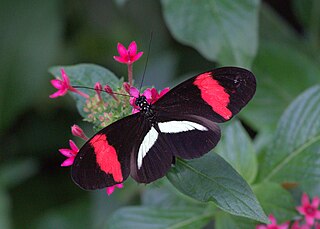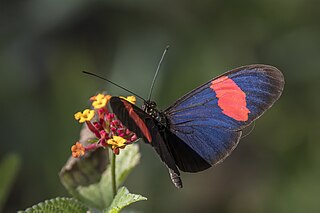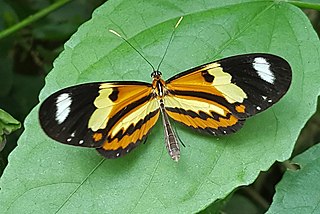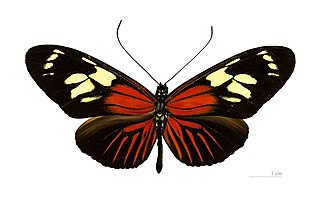
The Heliconiinae, commonly called heliconians or longwings, are a subfamily of the brush-footed butterflies. They can be divided into 45–50 genera and were sometimes treated as a separate family Heliconiidae within the Papilionoidea. The colouration is predominantly reddish and black, and though of varying wing shape, the forewings are always elongated tipwards, hence the common name.

The owl butterflies are species of the genus Caligo and are known for their huge eyespots, which resemble owls' eyes. They are found in the rainforests and secondary forests of Mexico, Central and South America.

Dryas iulia, commonly called the Julia butterfly, Julia heliconian, the flame, or flambeau, is a species of brush-footed butterfly. The sole representative of its genus Dryas, it is native from Brazil to southern Texas and Florida, and in summer can sometimes be found as far north as eastern Nebraska. Over 15 subspecies have been described.

Heliconius erato, or the red postman, is one of about 40 neotropical species of butterfly belonging to the genus Heliconius. It is also commonly known as the small postman, the red passion flower butterfly, or the crimson-patched longwing. It was described by Carl Linnaeus in his 1758 10th edition of Systema Naturae.

Heliconius cydno, the cydno longwing, is a nymphalid butterfly that ranges from Mexico to northern South America. It is typically found in the forest understory and deposits its eggs on a variety of plants of the genus Passiflora. It is a member of the Heliconiinae subfamily of Central and South America, and it is the only heliconiine that can be considered oligophagous. H. cydno is also characterized by hybridization and Müllerian mimicry. Wing coloration plays a key role in mate choice and has further implications in regards to sympatric speciation. Macrolide scent gland extracts and wing-clicking behavior further characterize this species.

Heliconius comprises a colorful and widespread genus of brush-footed butterflies commonly known as the longwings or heliconians. This genus is distributed throughout the tropical and subtropical regions of the New World, from South America as far north as the southern United States. The larvae of these butterflies eat passion flower vines (Passifloraceae). Adults exhibit bright wing color patterns which signal their distastefulness to potential predators.

Heliconius melpomene, the postman butterfly, common postman or simply postman, is a brightly colored, geographically variable butterfly species found throughout Central and South America. It was first described by Carl Linnaeus in his 1758 10th edition of Systema Naturae. Its coloration coevolved with another member of the genus, H. erato as a warning to predators of its inedibility; this is an example of Müllerian mimicry. H. melpomene was one of the first butterfly species observed to forage for pollen, a behavior that is common in other insect groups but rare in butterflies. Because of the recent rapid evolutionary radiation of the genus Heliconius and overlapping of its habitat with other related species, H. melpomene has been the subject of extensive study on speciation and hybridization. These hybrids tend to have low fitness as they look different from the original species and no longer exhibit Müllerian mimicry.
Heliconius nattereri is a species of butterfly in the family Nymphalidae. It is endemic to the Atlantic forest of Brazil.

The butterfly subtribe Euptychiina is a diverse group within the tribe Satyrini, occurring throughout Central and South America, in addition to a few species known from North America. Euptychiina is a predominantly lowland group, with the exception of one Asian taxon Palaeonympha opalinaButler, 1871 and the Andean genus ForsterinariaGray, 1973. The taxon was erected by Lee Denmar Miller.

Heliconiini is a tribe of butterflies in the subfamily Heliconiinae, also known as the passion-vine butterflies. This group has roughly 100 species and subspecies distributed primarily in the Neotropics.

Heliconius numata, the Numata longwing, is a brush-footed butterfly species belonging to the family Nymphalidae, subfamily Heliconiinae.

Pronophilina is a Neotropical subtribe of butterflies of the subfamily Satyrinae. They are a species-rich group with highest diversity in the tropical and subtropical mountains, especially the Andes. Before 1970, they were poorly studied, but recent interest has resulted in high rates of species description from previously unexplored mountain ranges. However, there is still a lack of knowledge on their biology and ecology. Their relationship to other groups of Satyrine butterflies and their complex patterns of speciation within and among mountain ranges have led to several biogeographic discussions.

Mechanitis lysimnia, the confused tigerwing, sweet-oil tiger or lysimnia tigerwing, is a species of butterfly of the family Nymphalidae. It was described by Johan Christian Fabricius in 1793. It is found in Central and South America, from southern Mexico to Uruguay. The habitat consists of disturbed forests at altitudes up to 1,500 metres (4,900 ft).

Heliconius burneyi, the Burney's longwing, is a butterfly of the family Nymphalidae. It was described by Jacob Hübner in 1831. It is found in the Amazon basin. The habitat consists of tall forests.

Heliconius demeter, the Demeter longwing, is a butterfly of the family Nymphalidae. It was described by Otto Staudinger in 1897. It is found in the Northern and Eastern part of the Amazon basin, from Guyana to Northern Brazil and Peru. The habitat consists of sandy rainforests.

Heliconius elevatus is a butterfly of the family Nymphalidae native to the Amazon Basin.

Heliconius ethilla, the ethilia longwing, is a butterfly of the family Nymphalidae. It was described by Jean-Baptiste Godart in 1819. It is found from Panama to southern Brazil. The habitat consists of marginal forests.

Heliconius wallacei, the Wallace's longwing, is a butterfly of the family Nymphalidae. It was described by Tryon Reakirt in 1866. It is found from Venezuela and Trinidad to southern Brazil and Peru. The habitat consists of lowland rainforests.

Heliconius eratosignis, the eratosignis longwing, is a butterfly of the family Nymphalidae. It was described by James John Joicey and George Talbot in 1925. It is found in the south-western Amazon basin, from Brazil to Peru and Bolivia. The habitat consists of sandy rainforests.

Marpesia berania, the amber daggerwing, is a butterfly in the family Nymphalidae. The species was first described by William Chapman Hewitson in 1852. They are a brightly colored, Neotropical butterfly with a unique wing shape, found in Central and northern South America. The amber daggerwing exhibits several interesting characteristics varying from their unusual behavior to their physical traits that make them so distinct.








